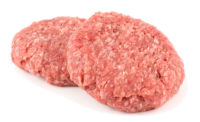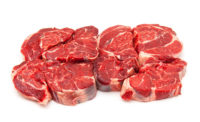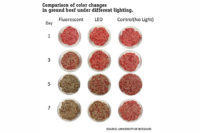 The 2010/2011 National Beef Tenderness Survey revealed that post-fabrication aging times for subprimal cuts in cold storage facilities ranged from 1 to 358 days for retail subprimals, and 9 to 67 days for foodservice subprimals. Currently, little information is available for product aged longer than 35 days. Our objective was to determine the consequences of aging, for 2, 14, 21, 42 and 63 days post-fabrication, on fluid loss, retail color stability and lipid oxidation of top loin, top round, top sirloin and bottom round steaks.
The 2010/2011 National Beef Tenderness Survey revealed that post-fabrication aging times for subprimal cuts in cold storage facilities ranged from 1 to 358 days for retail subprimals, and 9 to 67 days for foodservice subprimals. Currently, little information is available for product aged longer than 35 days. Our objective was to determine the consequences of aging, for 2, 14, 21, 42 and 63 days post-fabrication, on fluid loss, retail color stability and lipid oxidation of top loin, top round, top sirloin and bottom round steaks.
Beef strip loin, top (inside) round, top sirloin butt and outside round from USDA Select carcasses (n=12) were purchased from AB Foods (Toppenish, Wash.) and transported to the University of Idaho Meat Science Laboratory. Wholesale products were cut into five sections at least two inches thick on day two and randomly assigned to one of the five aging periods
(2, 14, 21, 42, and 63 days post-fabrication). Sections were vacuum shrink packaged and subsequently aged at 32°F. At the end of each aging period, one-inch thick steaks were cut from designated sections for retail shelf life. Steaks were placed in white Styrofoam trays, overwrapped with an oxygen-permeable PVC film, and displayed in a glass-fronted retail display case at 38°C for four days. The display case was equipped with natural white hg 40W lights, and the average light intensity was 409 lux.
Each section was weighed prior to vacuum packaging and after aging to determine percent purge during storage. Percent purge tended to increase for top loin steaks and increased for the other three muscles; see Table 1. Furthermore, steaks were weighed prior to and following retail display to determine percent retail fluid loss. In contrast to percent purge, percent retail fluid loss decreased with aging time for all four muscles, as shown in Table 1.
Thiobarbituric acid reactive substances, a measure of lipid oxidation, were quantified on days 0, 1, and 4 of retail display. Lipid oxidation, which leads to off flavors, increased with retail display time for all four muscles. It also increased with aging time for top loin and top sirloin steaks, indicating potential for increased off flavors.
Color measurements (L*-lightness, a*-redness, and b*-yellowness) were taken using a Hunter MiniScan EZ on days 0, 1, 2, 3, and 4. Interestingly, steaks became darker and less red during the final three aging periods with the exception of top round steaks, which became lighter with aging time. Based on our visual color scores, a* values below 30 would be considered unacceptable to the consumer.
Aerobic Count Plates were used to determine microbial growth on days 0 and 4 of retail display. Bacterial growth increased with longer aging periods but stayed below spoilage levels (log>7.0).
In conclusion, longer aging periods decrease shelf life due to unacceptable color and lipid oxidation. However, steaks from each muscle responded differently to aging and retail display. Therefore, aging time and muscle type must be taken into account when managing product at the retail level to reduce losses from meat unacceptable to the consumer.
Funded by The Beef Checkoff. We thank the Idaho Beef Council for their support of this project.



